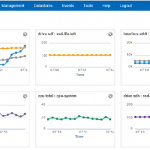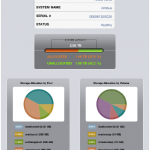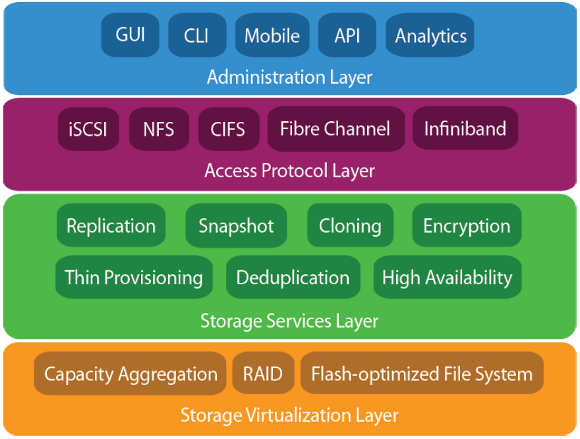Avevo già scritto un post riguardo Nimbus Data (conosciuti in occasione della mia trasferta al VMworld), descrivendo le caratteristiche principali della loro soluzione di storage basata su flash memory array (tra l’altro completamente autoprodotti).
Il cuore del loro prodotto è il sistema operativo HALO, che con la nuova versione HALO 2013 introduce nuove funzionalità a livello di gestione:
- funzione analytics per monitorare in tempo reale il funzionamento dello storage, oltre che fornire dati storici
- nuova REST-based API per gestire tutte le funzioni dello storage con strumenti multi-vendor, custom o comunque di terze parti
- nuova modalità di accesso access con HALO Mobile che porta nel palmo della mano le funzioni di gestione dello storage
HALO 2013 è un aggiornamento gratuto per tutti i clienti Nimbus Data con un support contract attivo. Notare che tutte le novità introdotte in HALO 2013 sono a livello di “administration layer”:
Advanced Flash Memory Analytics
 Extending Nimbus Data’s industry-leading unified storage, data protection, and efficiency features, the new HALO 2013 release adds powerful real-time and historical monitoring and reporting capabilities. Over 200 metrics are tracked, including flash endurance, capacity utilization, latency, power consumption, deduplication rates, and overall system health. Customers can view detailed port, host, and session-level statistics, easily navigating back-in-time to observe trends as well as honing in on specific data points at fine-grain intervals. A beautiful new web interfaces enables users to create customized dashboards highlighting key areas of interest, and built-in benchmarking creates IOps and throughput workloads to validate system performance. All statistics are stored in an industry-standard RRD format, enabling customers to utilize Nimbus tools as well as third-party charting software to view the results.
Extending Nimbus Data’s industry-leading unified storage, data protection, and efficiency features, the new HALO 2013 release adds powerful real-time and historical monitoring and reporting capabilities. Over 200 metrics are tracked, including flash endurance, capacity utilization, latency, power consumption, deduplication rates, and overall system health. Customers can view detailed port, host, and session-level statistics, easily navigating back-in-time to observe trends as well as honing in on specific data points at fine-grain intervals. A beautiful new web interfaces enables users to create customized dashboards highlighting key areas of interest, and built-in benchmarking creates IOps and throughput workloads to validate system performance. All statistics are stored in an industry-standard RRD format, enabling customers to utilize Nimbus tools as well as third-party charting software to view the results.
Open REST-based API
Targeting the needs of cloud infrastructure architects, HALO 2013 incorporates a powerful REST-based API (application programming interface), giving users the tools they need to easily integrate the administration and monitoring of Nimbus flash memory arrays into the rest of their data center infrastructure. Through the API, users can perform every function available, from provisioning iSCSI, Fibre Channel, Infiniband, and NFS datastores, to measuring deduplication and creating snapshots. The API captures all available statistics to feed into existing management software and analytics tools. Nimbus’ HALO API lets anyone build application-specific plug-ins, even full management software, eliminating costly license fees and proprietary single-vendor software.
Storage Management in the Palm of Your Hand
 Nimbus Data’s storage platforms are also now the first all-flash arrays to feature mobile management, enabling real-time streaming of important system performance, utilization, and health information directly to Apple iOS and Google Android-based devices. Available now for free on the Apple iTunes Store and Google Play store, the HALO Mobile app leverages the API to allow users to monitor system events, view dynamic live charts, and much more, all SSL-encrypted for maximum security. HALO Mobile brings IT administrators closer to their infrastructure, even as data centers become more remote, larger and more complex, to improve service levels and reduce complexity.
Nimbus Data’s storage platforms are also now the first all-flash arrays to feature mobile management, enabling real-time streaming of important system performance, utilization, and health information directly to Apple iOS and Google Android-based devices. Available now for free on the Apple iTunes Store and Google Play store, the HALO Mobile app leverages the API to allow users to monitor system events, view dynamic live charts, and much more, all SSL-encrypted for maximum security. HALO Mobile brings IT administrators closer to their infrastructure, even as data centers become more remote, larger and more complex, to improve service levels and reduce complexity.
Gemini Flash Memory Array
Lo storage può scalare fino a 1 PB per rack, 48 TB per ogni sistema da 2U (utilizzando i nuovi dischi SSD da 2 TB ciascuno) ed è caratterizzato da un funzione di Unified Storage che permette di lavorare sia in modalità SAN che NAS.
Anche il lato front-end garantisce il massimo della flessibilità, grazie alle connettività di tipo Ethernet, FC o Infiniband, risultato tra l’altro il primo storage con native flash ad implementare FDR Infiniband, i 40 GbE e i 16 Gb FC.
Infine va evidenziato il basso consumo valutato attorno agli 8 W per TB, che lo rende paraddosalmente adatto anche in scenari di service provider o hosting dove spazio (e la densità è molto alta) e consumo possono incidere molto sui costi di tipo Opex.











